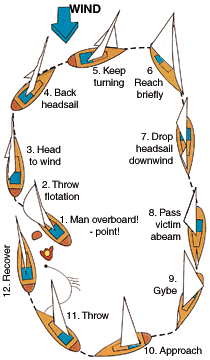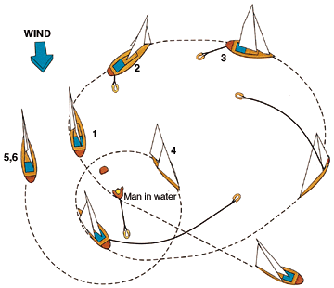The upcoming Shipwright’s Regatta is the start of the often windy spring sailing season. With rusty skills we may be heading out into challenging conditions. Before we untie from the dock it just makes good sense to check safety equipment, put on our PFD’s and review rescue procedures. Below is a post from the Royal Ocean Racing Club’s website that goes over some of the key elements in a successful crew overboard rescue.
 When a crew member goes over the side recovery time is of the essence. In an effort to come up with a recovery system that is simple and lightning quick, the US Yacht Racing Union Safety at Sea Committee, the US Naval Academy Sailing Squadron, the Cruising Club of America Technical Committee and the Sailing Foundation of Seattle, Washington, joined forces to conduct extensive research and sea trials. The result of their collaboration is the “Quick-Stop” method of man-overboard recovery. The hallmark of this method is the immediate reduction of boat speed by turning in a direction to windward and thereafter maneuvering at modest speed, remaining near the victim. In most instances, this is superior to the conventional procedure of reaching off, then either gibing or tacking and returning on a reciprocal course.
When a crew member goes over the side recovery time is of the essence. In an effort to come up with a recovery system that is simple and lightning quick, the US Yacht Racing Union Safety at Sea Committee, the US Naval Academy Sailing Squadron, the Cruising Club of America Technical Committee and the Sailing Foundation of Seattle, Washington, joined forces to conduct extensive research and sea trials. The result of their collaboration is the “Quick-Stop” method of man-overboard recovery. The hallmark of this method is the immediate reduction of boat speed by turning in a direction to windward and thereafter maneuvering at modest speed, remaining near the victim. In most instances, this is superior to the conventional procedure of reaching off, then either gibing or tacking and returning on a reciprocal course.
QUICK-STOP
1. Shout “man overboard” on the wind and designate a crew member to spot and point to the victim1s position in the water. The spotter should not take his eyes off the victim (see Figure 1 below).
2. Provide immediate flotation. Throw buoyant objects such as cockpit cushions, life rings and so on. These objects may not only come to the aid of the victim, but will “litter the water” where he went overboard and help your spotter to keep him in view. Deployment of the pole and flag (dan buoy) requires too much time. The pole is saved to “put on top” of the victim in case the initial manoeuvre is unsuccessful.
3. Bring boat head-to-wind and beyond (see Figure 1).
4. Allow headsail to back and further slow the boat.
5. Keep turning with headsail backed until wind is abaft the beam.
6. Head on beam-to-broad reach course for two or three lengths then go to nearly dead downwind.
7. Drop thc headsail while keeping the mainsail centred (or nearly so). The jib sheets are not slacked, even during the dousing manoeuvre, to keep them inside the lifelines.
8. Hold the downward course until victim is abaft the beam.
9. Gybe.
10. Approach the victim on a course of approximately 45 degrees to 60 degrees off the wind.
11. Establish contact with the victim with heaving line or other device. The Naval Academy uses a “throwing sock” containing 75 feet of light floating line and a kapok bag that can be thrown into the wind because the line is kept inside the bag and trails out as it sails to the victim.
12. Effect recovery over the windward side.
Quickstop Under Spinnaker
The same procedure is used to accommodate a spinnaker. Follow the preceding instructions. As the boat comes head-to-wind and the pole is eased to the head stay, the spinnaker halyard is lowered and the sail is gathered on the fore deck. The turn is continued through the tack and the approach phase commences.
Quickstop In Yawls & Ketches
Experiment with your mizzensail. During sea trials, it was determined that the best procedure was to drop the mizzen as soon as it is convenient to do so during the early phases of Quick-Stop.
Quickstop Using Engine
Use of the engine is not essential, although it’s advisable to have it running in neutral, during the Quick-Stop phase, unless it is needed in the final approach. Check first for trailing lines!
SHORTHANDED CREWS
When there are only two people sailing together and a man-overboard accident occurs, the remaining crew member may have difficulty in handling the recovery alone. If the victim has sustained injuries, getting him back aboard may be almost impossible. The Quick-Stop method is simple to effect by a singlehander, with only one alteration to the procedure: the addition of a specialised piece of equipment called the “Seattle Sling”, a floating horsecollar device that doubles as a hoisting sling. The Seattle Sling (illustrated on the following page) is attached to the boat by a length of floating line three or four times the boat1s length. When a crew member falls overboard the scenario should proceed as follows:
1. A cushion or other flotation is thrown while the boat is brought IMMEDIATELY head-to-wind, slowed and stopped (Figure 2 above).
2. The Seattle Sling is deployed by opening the bag that is hung on the stern pulpit and dropping the sling into the water. It will trail out astern and draw out the remaining line.
3. Once deployed, the boat is sailed in a wide circle around the victim with the line and sling trailing astern. The jib is not tended but allowed to back from the head-to-wind position, which increases the rate of turn.
4. Contact is established with the victim by the line and sling being drawn inward by the boat1s circling motion. The victim then places the sling over his head and under his arms.
5. Upon contact, the boat is put head-to-wind again, the headsail is dropped to the deck and the main is doused.
6. As the boat drifts slowly backward, the crew begins pulling the sling and the victim to the boat. If necessary, a cockpit winch can be used to assist in this phase, which should continue until the victim is alongside and pulled up tightly until he is suspended in the sling (so that he will not drop out).
